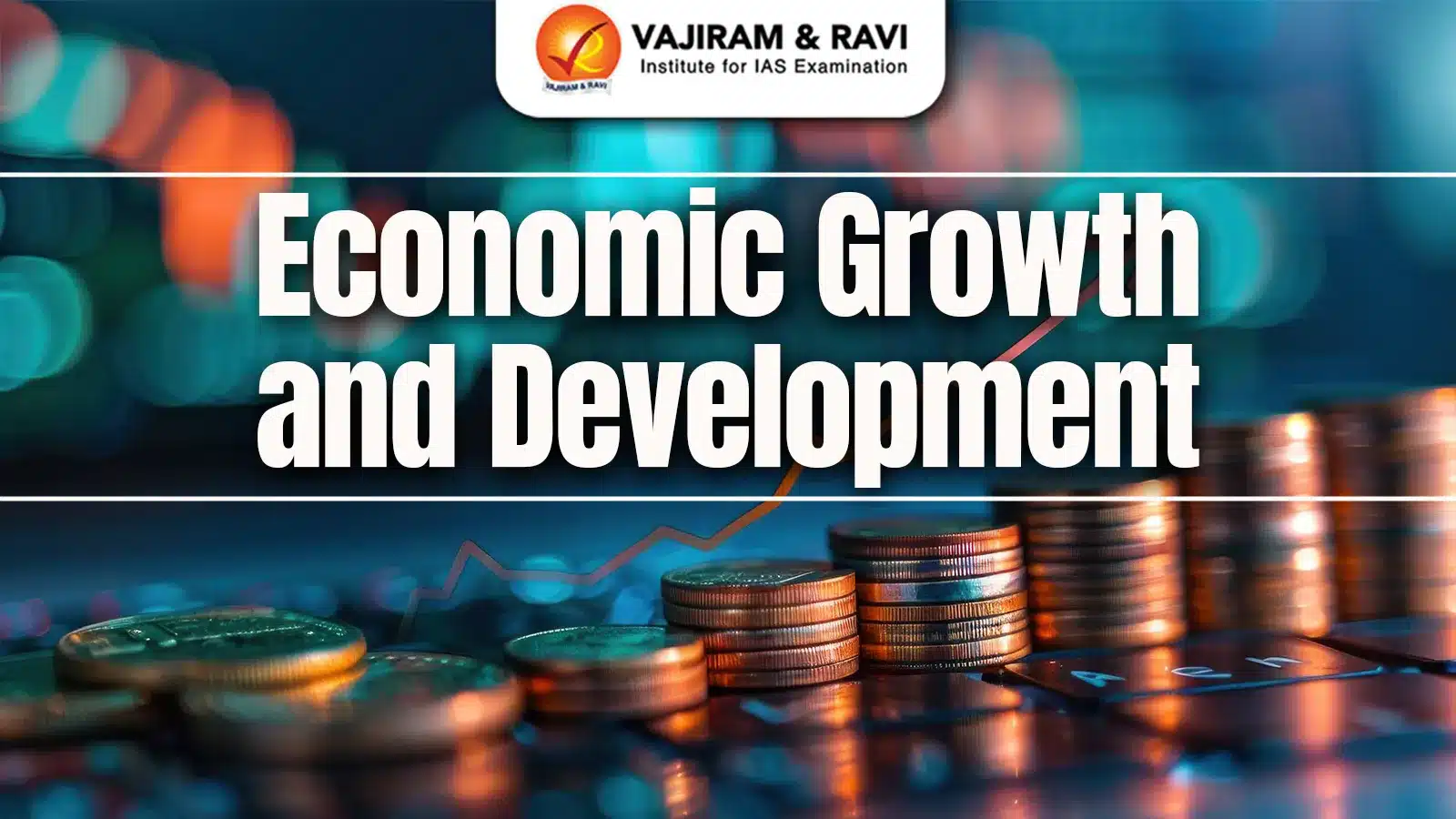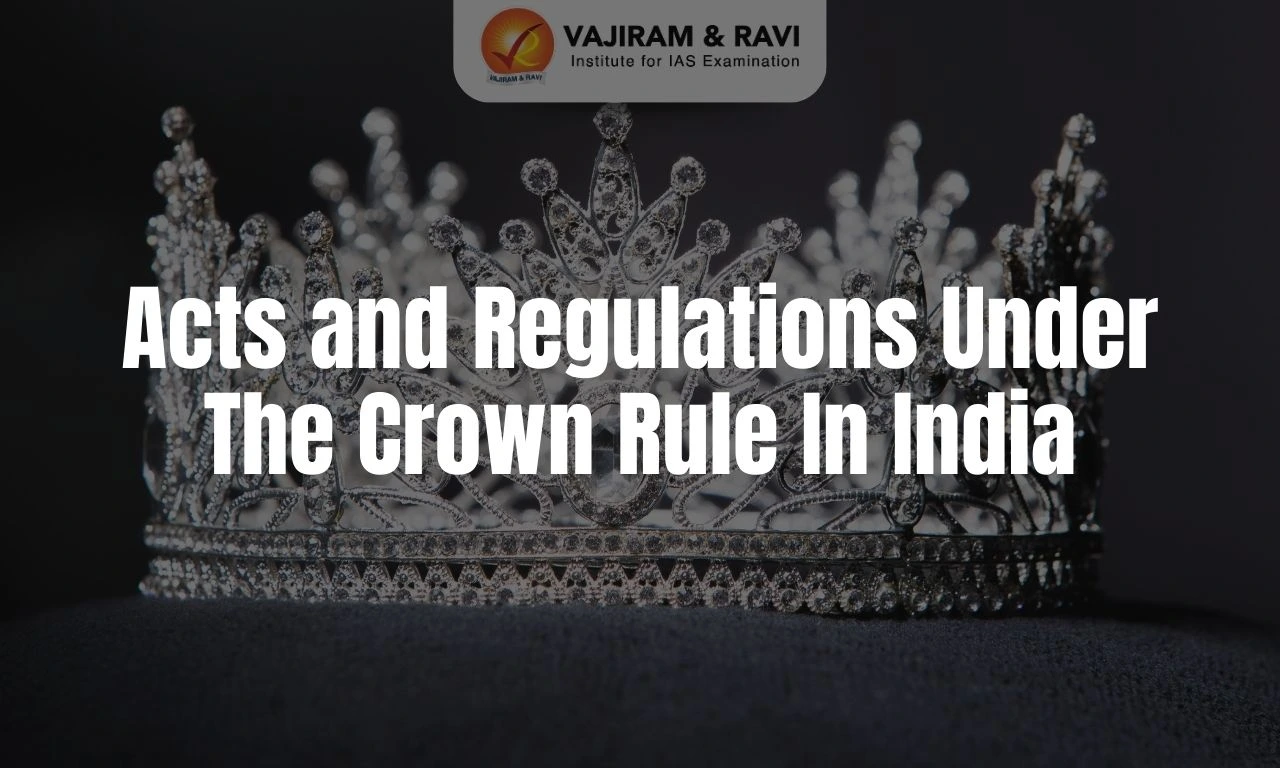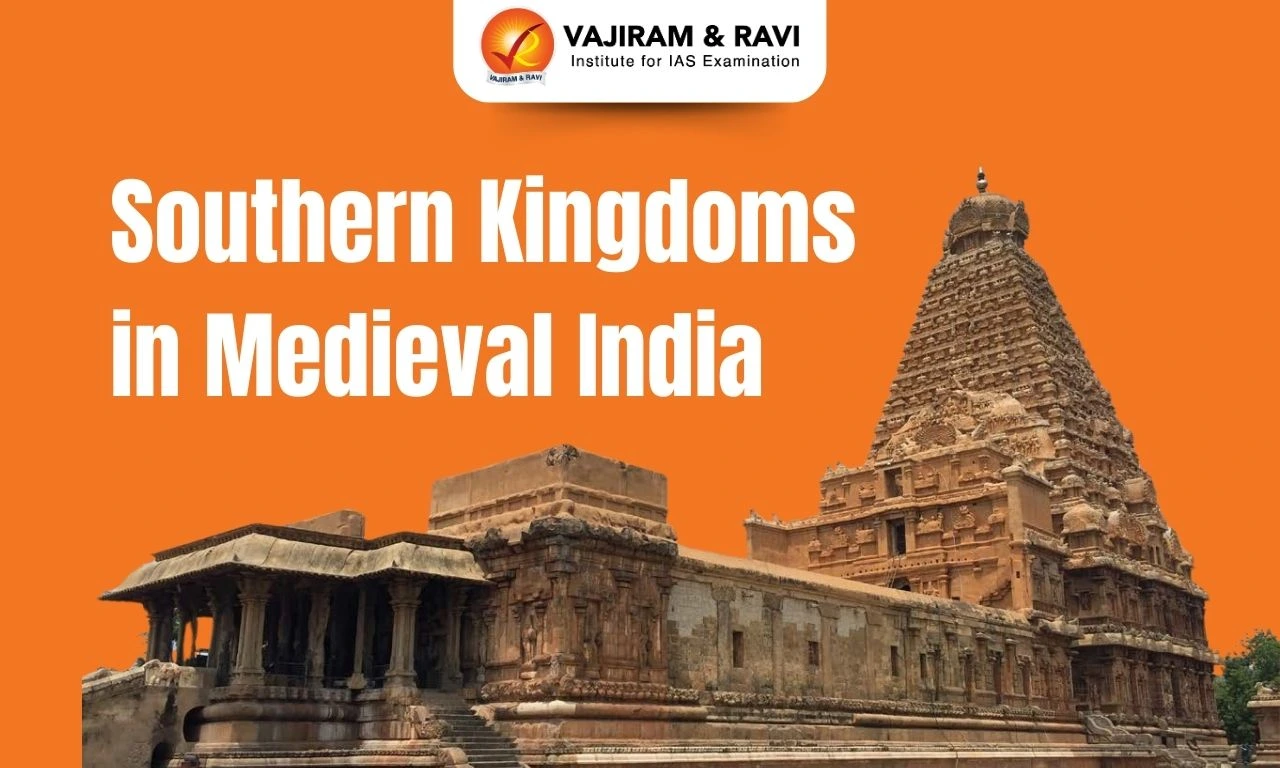Economic Growth and Development are key indicators of a nation’s progress and prosperity. Economic growth refers to the increase in a country’s output of goods and services, typically measured by the rise in Gross Domestic Product (GDP). Development, however, encompasses a broader perspective, including improvements in living standards, education, healthcare, and income distribution.
While economic growth focuses on quantitative expansion, development emphasizes qualitative changes that enhance the well-being of the population. India’s growth, driven by reforms, faces challenges like unemployment, inequality, poor infrastructure, and inefficient agriculture, despite initiatives like "Make in India" and "Atmanirbhar Bharat."
Economic Growth and Development
The terms ‘economic growth’ and ‘economic development’ may appear similar, but they differ in meaning. Economic growth refers to a quantitative increase in a country’s output, whereas economic development is a qualitative improvement in overall living standards.
Economic Growth
Economic growth refers to the increase in a country's real national income or per capita income over time. It is typically measured by the rise in real Gross Domestic Product (GDP) or per capita GDP. Key characteristics of economic growth include:
- Increase in National and Per-Capita Income: Economic growth is often measured by the rise in national income and per-capita income, which indicates an improvement in the standard of living for the population.
- Real Income Measurement: Economic growth is assessed by the increase in real national income, reflecting actual increases in goods and services output, not just nominal income increases due to price inflation.
- Sustained Over Time: True economic growth involves a consistent increase in real income over the long term, distinguishing it from short-term or seasonal fluctuations.
- Productive Capacity: For growth to be sustainable, it must be based on improvements in the economy’s productive capacity, such as technological advancements or enhanced infrastructure.
Economic Development
Economic development is a broader concept that encompasses sustained improvements in the material well-being of society. It goes beyond mere income increases to include social, cultural, and institutional changes that contribute to overall progress. Key aspects of economic development include:
- Comprehensive Improvement: Economic development involves changes in income, savings, investment, and socio-economic structures, including improvements in technology, skills, and institutional frameworks.
- Qualitative and Quantitative Changes: While it includes quantitative growth in national income, economic development also emphasizes qualitative improvements in the quality of life, such as better health care, education, and poverty alleviation.
- Equity and Welfare: Economic development aims to achieve more equitable income distribution and enhance the overall well-being of the population through better employment opportunities and social equity.
Indicators of Growth and Development
Indicators of growth and development help assess the economic progress and overall well-being of a country. Economic growth is typically measured using Gross Domestic Product (GDP), per capita income, and industrial output. However, growth alone does not reflect the quality of life or equitable distribution of resources.
- Broader development indicators include the Human Development Index (HDI), Multidimensional Poverty Index (MPI), Gender Inequality Index (GII), and Gini Coefficient (for income inequality).
- Other key indicators are literacy rate, life expectancy, infant mortality rate, and access to basic services.
- These indicators provide a holistic view by combining social, economic, and environmental dimensions.
- Reliable indicators are essential for effective policy formulation, identifying gaps in human welfare, and tracking progress toward inclusive and sustainable development goals.
Factors Influencing Growth and Development
Economic growth and development are shaped by a mix of economic, social, political, and environmental factors. These elements interact to determine a nation's progress, equity, and long-term sustainability in improving human well-being.
- Economic Factors: Growth is driven by capital formation, technological progress, investments, infrastructure, trade openness, FDI inflows, and macroeconomic stability.
- Human Capital: A skilled, educated, and healthy population boosts productivity and supports sustainable development.
- Governance and Institutions: Good governance, political stability, and strong institutions are essential for effective policy execution and economic confidence.
- Social and Environmental Factors: Access to education, healthcare, gender equality, social cohesion, natural resources, geography, and climate resilience all shape inclusive and balanced growth.
Difference between Economic Growth and Development
The Difference between Economic Growth and Development lies in their scope and impact. While economic growth refers to an increase in a country's output or income, development includes improvements in living standards and well-being.
|
Aspect |
Economic Growth |
Economic Development |
|
Meaning |
Refers to the increase in real output of goods and services, typically measured by the rise in GDP or per capita income. |
Involves broader changes including improvements in social, cultural, and economic structures, leading to enhanced quality of life and equitable income distribution. |
|
Factors |
Focuses on components of GDP such as consumption, investment, government spending, and net exports. |
Includes factors like human capital growth, reduced inequality, and structural changes that improve the quality of life. |
|
Measurement |
Measured by quantitative factors such as real GDP growth or per capita income. |
Assessed through qualitative measures like the Human Development Index (HDI), gender-related development index, and poverty indices. |
|
Effect |
Leads to quantitative increases in national income and output. |
Results in both qualitative and quantitative improvements reflect progress in living standards and overall societal well-being. |
|
Relevance |
Indicates economic performance in terms of output and income, often used as a measure of economic success. |
Reflects broader progress in improving life quality, addressing inequality, and achieving sustainable development goals. |
Economic Growth and Development in India
India’s economic journey has evolved from early socialist-driven industrialisation and challenges like low income and literacy rates to the Green Revolution and 1991 liberalisation reforms that dismantled the License Raj. Yet, labour market and infrastructure issues remain.
- Initial Economic Challenges (1950s): India’s per capita income was extremely low, with 75% of the population engaged in agriculture, and literacy at only 14%, while the average life expectancy was 32 years.
- Early Economic Strategy (1950s-60s): The government prioritised industrialisation through state-owned enterprises, focusing on heavy industries and centrally planned five-year plans while sidelining agriculture.
- Shortfalls of the Early Strategy: State-owned enterprises became inefficient, the License Raj restricted private sector growth, and land redistribution in agriculture largely failed, leading to stagnation.
- Crisis and Shift in Policy (1960s-70s): A food crisis in the mid-1960s led to the Green Revolution, improving food production, but industrial stagnation and flawed policies hindered economic progress.
- Economic Liberalisation (1991): Liberalisation reforms in 1991, driven by a foreign exchange crisis, dismantled the license Raj, spurred growth to 6.3%, and reduced poverty rates significantly.
- Remaining Challenges: Despite progress, India still faces labour market issues, poor public services, weak infrastructure, and restrictive labour laws limiting job creation and manufacturing growth.
Present Scenario of Indian Economic Growth and Development
India, one of the fastest-growing economies, surpassed Japan to become the fourth-largest economy and aims to reach high middle-income status by 2047 and achieve net-zero emissions by 2070.
- Economic Growth and Development: India’s GDP reached $4 trillion in 2025, with a per capita income of $2,880. Key reforms like GST, "Make in India," and digital initiatives have fueled domestic consumption and private investment, driving 7.2% growth.
- Fiscal Policy: Prudent fiscal management reduced the fiscal deficit from 13% in FY20- 21 to 5.1% projected for FY24- 25. Key initiatives like Atmanirbhar Bharat have promoted self-reliance and domestic production, with state and central debt at 85% of GDP.
- International Comparisons: India’s foreign exchange reserves hit $685.7 billion in May 2025, supported by strong Foreign Direct Investment (FDI) inflows and exports, positioning the country strongly in global financial rankings.
- Poverty Reduction: Multidimensional poverty declined from 29.17% in 2013-14 to 11.28% in 2022-23, although over 230 million families remain in poverty, requiring sustained government intervention.
- Inequality and Employment: Income inequality persists with a Gini index of 35, while 35.5% of children are malnourished. Employment indicators have improved, but challenges around job quality and low female labour participation remain.
- The top 1% of India's population owns 40% of the country's wealth. In 2022-23, 22.6% of the national income went to the top 1%, the highest level since 1922.
- Infrastructure and Industrial Growth: Projects like Bharatmala and Sagarmala have boosted connectivity, while "Made in India" attracts foreign investment and spurs industrial growth.
Economic Growth and Development Challenges
Since 1991, India has embraced free-market liberalisation, increased trade openness, and infrastructure investment, all of which have contributed to rapid economic growth. However, several obstacles continue to impede inclusive and sustainable development.
- Unemployment: Despite rapid economic growth, unemployment remains high, especially among the unskilled in rural and urban areas.
- In 2017, the official unemployment rate was just below 5%, but about 28 million educated youth in India are still unemployed.
- Poor Educational Standards: While India's large English-speaking population supports industries like call centres, high illiteracy rates, particularly in rural areas and among women, limit economic development.
- Poor Infrastructure: India’s inadequate infrastructure remains a major constraint on growth. For example, over 40% of agricultural produce rots before reaching markets due to supply chain weaknesses, contributing to food wastage and economic loss.
- Rising Inequality: Economic growth has widened the gap between rich and poor, with 33% of the population living on less than $1 per day, highlighting the need for more inclusive development policies.
- Inefficient Agriculture: Agriculture employs over 51% of India’s workforce but contributes only 17.4% to GDP, highlighting its inefficiency. Slow modernisation, limited reforms in land use, irrigation, and market access hinder productivity, leaving many workers in poverty.
- Poor Tax Collection Rates: India’s tax revenue, at just 12% of GDP, is one of the lowest in the world, mainly due to widespread tax avoidance, corruption, and complex tax structures.
- Regional Inequality: India’s economic growth has largely benefited urban centres like Delhi and Mumbai, while many rural and northeastern regions remain underdeveloped.
- This uneven growth has led to migration, congestion in urban areas, and growing inequality between regions.
Economic Growth and Development Initiatives
To address the challenges associated with economic growth and foster development, the Government of India has launched several key initiatives aimed at boosting manufacturing and enhancing economic resilience. These initiatives promote investment, streamline processes, and build infrastructure to support sustainable growth.
- Make in India: Launched on September 25, 2014, this initiative aims to transform India into a global manufacturing hub by fostering investment, innovation, and world-class infrastructure.
- Atmanirbhar Bharat (Self-reliant India): Launched during the COVID-19 pandemic, this initiative aims to make India self-sufficient by promoting local manufacturing, reducing import dependence, and boosting sectors through financial packages and reforms.
- PM Gati Shakti National Master Plan (NMP): A GIS-based platform launched in October 2021 to integrate multimodal infrastructure planning and enhance efficiency.
- National Logistics Policy (NLP): Launched on September 17, 2022, this policy aims to reduce logistics costs and develop a comprehensive framework for the logistics ecosystem.
- National Infrastructure Pipeline (NIP): This initiative aims to invest in infrastructure projects across the country, such as roads, railways, ports, and airports, to improve connectivity and boost economic growth.
- FAME-India Scheme (Phase-II): Promotes the adoption and manufacturing of electric vehicles (EVs) with incentives and support.
- Digital India: This initiative seeks to transform India into a digitally empowered society and knowledge economy by improving online infrastructure, increasing internet connectivity, and making government services available electronically.
- Swachh Bharat Abhiyan: Launched on October 2, 2014, it aims to achieve a ‘Clean India’ through nationwide cleanliness drives.
Economic Growth and Development UPSC PYQs
Question 1: Faster economic growth requires increased share of the manufacturing sector in GDP, particularly of MSMEs. Comment on the present policies of the government in this regard. (UPSC Mains 2023)
Question 2: Increase in absolute and per capita real GNP do not connote a higher level of economic development, if: (UPSC Prelims 2018)
(a) industrial output fails to keep pace with agricultural output.
(b) agricultural output fails to keep pace with industrial output.
(c) poverty and unemployment increase.
(d) imports grow faster than exports.
Answer: (c)
Question 3: A decrease in tax to GDP ratio of a country indicates which of the following? (UPSC Prelims 2015)
- Slowing economic growth rate
- Less equitable distribution of national income
Select the correct answer using the code given below.
(a) 1 only
(b) 2 only
(c) Both 1 and 2
(d) Neither 1 nor 2
Answer: (a)
Question 4: Consider the following specific stages of demographic transition associated with economic development: (UPSC Prelims 2012)
- Low birthrate with low death rate
- High birthrate with high death rate
- High birthrate with low death rate
Select the correct order of the above stages using the codes given below:
(a) 1, 2, 3
(b) 2, 1, 3
(c) 2, 3, 1
(d) 3, 2, 1
Answer: (c)
Question 5: Economic growth is usually coupled with? (UPSC Prelims 2011)
(a) Deflation
(b) Inflation
(c) Stagflation
(d) Hyperinflation
Answer: (b)
Last updated on December, 2025
→ Check out the latest UPSC Syllabus 2026 here.
→ Join Vajiram & Ravi’s Interview Guidance Programme for expert help to crack your final UPSC stage.
→ UPSC Mains Result 2025 is now out.
→ UPSC Notification 2026 is scheduled to be released on January 14, 2026.
→ UPSC Calendar 2026 is released on 15th May, 2025.
→ The UPSC Vacancy 2025 were released 1129, out of which 979 were for UPSC CSE and remaining 150 are for UPSC IFoS.
→ UPSC Prelims 2026 will be conducted on 24th May, 2026 & UPSC Mains 2026 will be conducted on 21st August 2026.
→ The UPSC Selection Process is of 3 stages-Prelims, Mains and Interview.
→ UPSC Result 2024 is released with latest UPSC Marksheet 2024. Check Now!
→ UPSC Prelims Result 2025 is out now for the CSE held on 25 May 2025.
→ UPSC Toppers List 2024 is released now. Shakti Dubey is UPSC AIR 1 2024 Topper.
→ UPSC Prelims Question Paper 2025 and Unofficial Prelims Answer Key 2025 are available now.
→ UPSC Mains Question Paper 2025 is out for Essay, GS 1, 2, 3 & GS 4.
→ UPSC Mains Indian Language Question Paper 2025 is now out.
→ UPSC Mains Optional Question Paper 2025 is now out.
→ Also check Best IAS Coaching in Delhi
Economic Growth and Development FAQs
Q1. What is the economic of growth and development?+
Q2. What are the 4 stages of economic growth?+
Q3. What are the 5 differences between growth and development?+
Q4. What are the 4 factors of economic growth?+
Q5. What is called economic growth?+
Tags: economic growth and development quest upsc economy notes

















